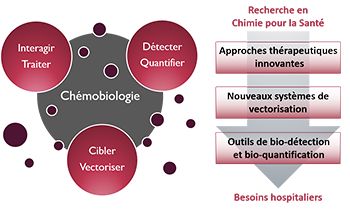- ⌂
-
Le DPM
Les Equipements
L'Environnement
Zoom sur... Le Bâtiment André Rassat
Nommé d'après une figure tutélaire de la chimie grenobloise, ce bâtiment est recouvert d’une double peau en feuille métallique qui apporte une protection thermique sur 3 côtés et crée une unité architecturale favorisant l'intégration parmi les arbres du site.
-
Thématiques
Le Thème
« Approches thérapeutiques innovantes »De nouvelles solutions thérapeutiques, de la cible biomacromolécu-laire émergente aux approches originales pour traiter les maladies
Le Thème
« Nouveaux systèmes de vectorisation »Combiner les propriétés d’inclusion de principes actifs, de franchisse-ment de barrières, d’adressage et de relar-gage en milieu vivant
Le Thème
« Outils de bio-détection et bio-quantification »Des dispositifs analytiques originaux pour la détection de cibles, de l’ion au micro-organisme en milieu complexe
Zoom sur... La Chémobiologie

-
Équipes
L'Équipe « COMET »
« COMET » développe la conception rationnelle, la synthèse et/ou l'extraction de composés à forte diversité/complexité comme nouveaux agents thérapeutiques et outils moléculaires pour la pénétration cellulaire ou la détection de biomolécules, actifs in vivo.L'Équipe « NOVA »
« NOVA » utilise des acides nucléiques fonctionnels comme éléments de reconnaissance pour des applications thérapeutiques ou diagnostiques, comme la sélection d'oligonucléotides, ou le développement de dispositifs d'analyses et de nanovecteurs.Les Services
-
Productions
Les Publications
La Vulgarisation
Les JSM
Zoom sur... La 12ème JSM (15 juin 2023)
Le DPM organise des journées scientifiques consacrées au médicament. L'objectif est de rassembler les spécialistes académiques et industriels autour d'une thématique. 2023 : Apports de la Chimie Click et de la Lumière en Chemobiologie
-
Partenariats
Les Formations
Les Consortiums
Les Financements
Zoom sur... L'environnement Grenoblois
Le DPM est un acteur central sur le bassin grenoblois en chimie, biologie et santé, lié au CHU Grenoble Alpes et à de nombreuses autres organisations : Pole de Recherche CBS, ICMG, Labex ARCANE, EUR CBH, Institut Carnot Polynat, Réseau GREEN.
Article
- Projet
- Eric PEYRIN, Corinne RAVELET, Emmanuelle FIORE,
- Titre
- A Lifetime-Sensitive Fluorescence Anisotropy Probe for DNA-based Bioassays: the Case of SYBR Green
-
[Full paper
 ]
] - Auteurs
- B. Chovelon, E. Fiore, P. Faure, E. Peyrin, C. Ravelet
- Edition
- Biosens. Bioelectron. 2017, 90, 140-145.
- Année
- 2017
- Résumé
- In standard steady-state fluorescence anisotropy (FA) DNA-based assays, the ligand binding to a given receptor is typically signalled by the rotational correlation time changes of the tracer. Herein, we report a radically different strategy that relies on the peculiar excited state lifetime features of the SYBR Green (SG) dye. This DNA-binding probe exhibits a drastically short lifetime in solution, leading to a high FA signal. Its complexation to oligonucleotides determines a singular and very large depolarization depending on the concerted effects of extreme lifetime enhancement and resonance energy homotransfer. On the basis of ligand-induced changes in the molar fractions of bound and free forms of SG, the approach provides an unprecedented means for the FA monitoring of the ligand binding to short DNA molecules, allowing the elaboration of a variety of intercalator displacement assays and label-free biosensors that involve diverse DNA structures (duplex, hairpin, G-quadruplex and single-stranded), ligand types (ion, small organic molecule and protein) and binding modes (intercalation, minor groove, allosteric switch). These findings open up promising avenues in the design of a new generation of FA assays.




 Annuaire
Annuaire Contact
Contact Plan d'accès
Plan d'accès ENG
ENG Login
Login



